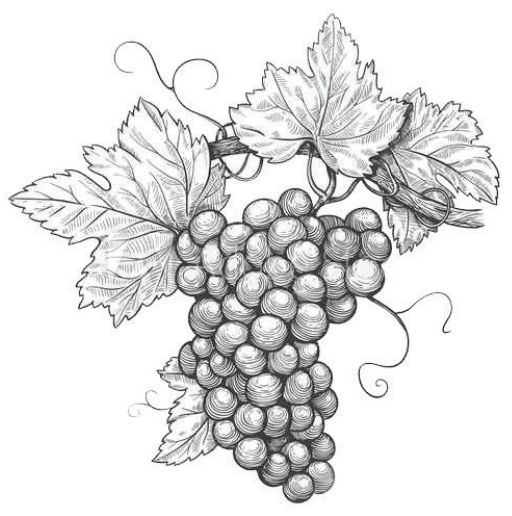Grape varieties suitable for cultivation by home gardeners in Connecticut include American, European and French-American hybrids. American grapes that are hardy in Connecticut are mainly derived from the fox grape (Vitis labrusca). Concord, Catawba, Reliance and Niagara are popular American varieties.
French-American hybrids are crosses between the Old World viniferas and Native American grape species. Both these hybrids and the European vinifera grapes (V. vinifera) are primarily grown for wine making purposes. Grape varieties of European origin may not be reliably winter hardy throughout the state. Several French-American hybrids like Seyval Blanc and Vidal Blanc exhibit greater cold tolerance.
All grape cultivars have similar phosphorus and potassium requirements. American varieties may need greater amounts of nitrogen to perform well. Soil pH preferences, however, differ considerably. American grape varieties require an acidic soil with an ideal pH of 5.5. They have a relatively high iron requirement and iron solubility increases under acidic conditions. European vinifera varieties prefer the soil pH to be about 6.5. European-American hybrids vary in their pH preference depending on which parent they resemble most.

Once established, grapevines can be productive for 40 years or more. Adequate soil preparation before planting will contribute to successful vine establishment.
Six months to one year before planting:
Have the soil tested. Add any necessary limestone at the rate recommended on the soil test results. Liming to a pH higher than 5.5 for American varieties or 6.5 for European varieties is not recommended. If soil test magnesium values are below optimum and the pH needs to be raised, use a dolomitic limestone. This type of limestone contains both calcium and magnesium. In situations where the soil pH level does not need to be changed but soil magnesium levels are below optimum, incorporate 1 pound of Epsom salts (MgSO4 ) per 100 sq. ft. Retest soil every 3 years to monitor pH levels.
If soil test phosphorus is below optimum, apply triple superphosphate (0-45-0) at the rate of ½ pound (1 cup) or bonemeal (1-11-0) at the rate of 2 ¼ lbs. (6 ¾ cups) per 100 sq. ft. If soil test potassium is below optimum, add potassium sulfate (0-0-50)* at a rate of ¾ lb. (1 ½ cups) or sul-po-mag (0-0-22) at the rate of 1 ½ lbs. (2 cups) per 100 square feet. Incorporate all necessary amendments to a depth of 6 to 8 inches. Retest soil one month before planting.
Fertilizers:
Year of planting: Without a soil test, apply 2 ounces (1/4 cup) of 10-10-10 per vine soon after growth begins, and again about 4 weeks later. Spread evenly over an area 4 to 5 feet in diameter.
Second year: Without a soil test, Apply 4 ounces (1/2 cup) of 10-10-10 per vine soon after growth begins, and again about 4 weeks later. Spread evenly over an area 4 to 5 feet in diameter.
Third year and older: Without a soil test, apply 1/2 lb. (1 cup) of 10-10-10 per each European grapevine or 1 pound (2 cups) of 10-10-10 per each American grapevine at budbreak. Spread evenly over an area 3 to 5 feet wide on each side of vine.
If soil test potassium and phosphorus are above optimum, apply only a source of nitrogen to the vines. Urea (46-0-0) at 2 to 3 ounces (1/2 cup) or bloodmeal (12-0-0) at 8 ounces (1 ½ cups) per vine will supply the desired amounts of nitrogen. Excessive vegetative growth indicates the need to reduce the amount of nitrogen by one half or omit entirely for one to two years.
Once every 3 years a borax application may be beneficial. Borax (10 to 12% boron) should be applied at not more than ¾ ounce (about 2 tablespoons) per 100 sq. ft. Excess boron can cause plant injury. Borax can be dissolved in water and sprayed onto the ground. In order to prevent damage to the sprayer, strain out sediments after borax has dissolved. Note that plants fertilized with natural/organic sources of nutrients rarely will require added boron.
*Avoid use of potassium chloride (KC1) as chloride injury may occur.
NOTE:
10 lbs of 10-10-10 will supply plants with 1 lb. of Nitrogen (N), 1 lb. of Phosphate (P2 O5 ) and 1 lb of Potash (K2 O) per 1000 sq. ft. (Phosphate is a form of phosphorus; Potash is a form of potassium)
10 lbs of 5-10-10 will supply plants with 1/2 lb. of Nitrogen (N), 1 lb. of Phosphate ( P2 O5 ) and 1 lb. of Potash (K2 O) per 1000 sq. ft. 10 lbs. of 5-10-5 will supply plants with ½ lb. of Nitrogen (N), 1 lb. of Phosphate ( P2 O5 ) and 1/2 lb. of Potash (K2 O) per 1000 sq. ft.
To supply nutrients using natural/organic sources use the following equivalents:
1 lb. of Nitrogen can be supplied by 8.3 lbs. of bloodmeal (12-0-0) or 11 lbs. of corn gluten (9-0-0).
1 lb. of Phosphate can be supplied by 6.75 lbs. of bonemeal (3-15-0) or 33.5 lbs. of rock phosphate (0-3-0).
1 lb. of Potash can be supplied by 25 lbs. of kelp meal (1-0-4) or 4.5 lbs. of sul-po-mag (0-0-22)* or 2 lbs. of potassium sulfate (0-0-50)**.
Keep in mind that the NPK analysis of natural organic products may vary by producer and adjust your application rates accordingly.
*Note: May need to be special or mail ordered.
**Note: Not all sources are certified for organic production
By Dawn Pettinelli, Associate Extension Educator, PSLA. Written 2001, Revised 2015, 2023.
Questions? Contact:
UConn Soil Nutrient Analysis Laboratory
Department of Plant Science and Landscape Architecture
Phone: 860.486.4274
Email: soiltest@uconn.edu
Website: soiltesting.cahnr.uconn.edu
UConn is an equal opportunity program provider and employer.
©UConn Extension. All rights reserved.